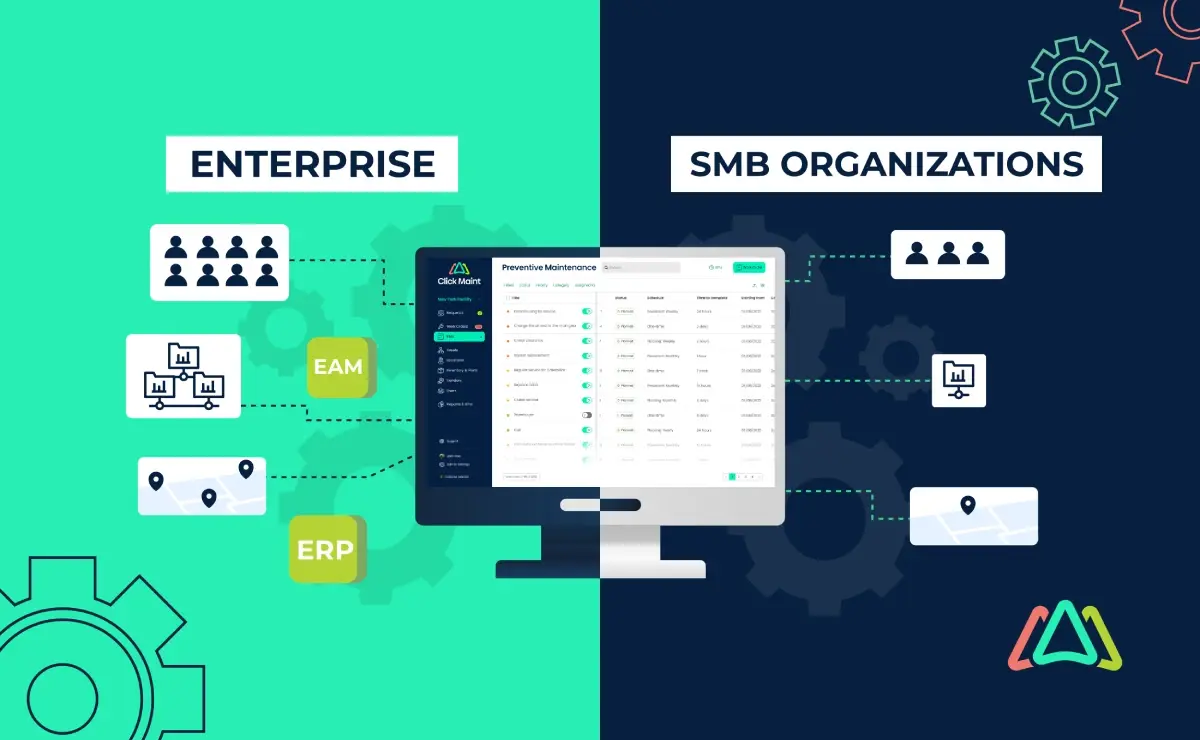
CMMS for Enterprise vs. SMB: What are the Differences?
Introduction:
Computerized Maintenance Management Systems (CMMS) have emerged as essential tools for businesses of all sizes primarily because of the software’s unique ability to streamline maintenance operations. While CMMSs are sought after by both large and small companies, it’s important to note that their needs and requirements are not all the same.
Understanding the differences in CMMS utilization for enterprises and small to medium businesses (SMBs) is crucial for making informed decisions when selecting the right CMMS solution for your organization. We’ll also identify areas of overlap and discuss how each is better suited for companies with specific needs. Let’s begin by creating a framework for each organization type and highlighting their structural and functional differences.
Differences Between Enterprise and SMB Organizations

Enterprise organizations and small to medium-sized businesses (SMBs) face unique challenges in maintenance management. Their significant differences in scale, resources, and organizational complexity directly impact their maintenance management needs.
Enterprise Organizations

Enterprises typically operate on a larger scale, with multiple departments, diverse facilities, and extensive infrastructure. This complexity requires a centralized and often sophisticated approach to maintenance management. Enterprises usually have dedicated maintenance teams or entire departments overseeing facilities, equipment, and IT systems. They might employ advanced maintenance management software (CMMS) to track and schedule maintenance tasks, manage inventory, and ensure compliance with regulatory standards. Here, The focus is optimizing uptime, reducing downtime, and providing operational continuity across various assets.
SMB Organizations
In contrast, SMBs are characterized by their smaller scale and more streamlined operations. Maintenance management in SMBs is less formalized and centralized than in enterprises. Often, maintenance responsibilities are handled by a few key personnel or even outsourced to external contractors. Due to limited resources for proactive planning, SMBs may utilize more straightforward tools for maintenance tracking and rely more on reactive maintenance strategies. The emphasis is typically on cost-efficiency and immediate operational needs rather than long-term asset management strategies.
These differences significantly impact maintenance management needs. Enterprises prioritize predictive and preventive maintenance to minimize disruptions and optimize asset lifespan. They invest in robust systems to manage large volumes of maintenance data and ensure regulatory compliance across multiple locations. On the other hand, SMBs focus on flexibility and cost-effectiveness, often preferring reactive maintenance approaches to address immediate issues. They may use more straightforward tools or outsource maintenance functions to control expenses while maintaining operational continuity. Thus, the scale and organizational structure of enterprises versus SMBs fundamentally shape their maintenance management strategies and tools.
Before delving into the specific needs and requirements of Enterprise and SMB organizations, it’s essential to have a quick review of what a CMMS is and what it can offer. This quick review will provide you with a basic understanding of the system, making it easier to grasp its application in different organizational settings.
Understanding CMMS

Simply put, a CMMS software solution is designed to help organizations manage and track maintenance activities, including equipment repairs, preventive maintenance, work orders, inventory management, etc. It provides a centralized platform for maintenance teams to streamline processes, improve efficiency, and reduce downtime.
A CMMS is a crucial tool for modern maintenance management. By digitizing maintenance operations, CMMS replaces manual processes and spreadsheets by offering a more organized and efficient way to handle maintenance tasks. The system helps schedule and track work orders, ensure timely preventive maintenance tasks, and manage spare parts inventory to avoid stockouts or overstock situations. CMMS can also generate detailed reports and analytics, providing insights into maintenance performance, equipment reliability, and overall operational efficiency.
Moreover, a CMMS makes better communication and coordination between maintenance teams and departments possible. Maintenance technicians can access the system via mobile devices, allowing real-time updates and quick response to maintenance requests. The software also supports compliance with industry regulations by maintaining accurate records of maintenance activities and ensuring that all required tasks are completed. Ultimately, by leveraging a CMMS, organizations can achieve more excellent asset uptime, extend the lifespan of their equipment, and reduce maintenance costs, contributing to improved productivity and profitability.
These benefits allow organizations to increase their bottom line, service their customers well, and remain competitive in a challenging marketplace. The potential of CMMS to manage the different needs and requirements of Enterprise and SMB organizations is promising.
How CMMS Addresses the Different Needs and Requirements of Enterprises and SMBs
1. Scalability and Complexity
Enterprise-level CMMS solutions excel in scalability and handling complexity due to their robust architecture to manage large volumes of data and multiple locations. These systems are built to accommodate diverse maintenance workflows across expansive operational landscapes, integrating seamlessly with other enterprise-level systems such as ERP and EAM. This scalability allows enterprises to maintain comprehensive asset hierarchies and manage intricate maintenance processes efficiently.
In contrast, SMB-focused CMMS solutions prioritize simplicity and ease of use. While they may lack the extensive scalability of their enterprise counterparts, they offer tailored features that meet the needs of smaller organizations with more straightforward maintenance requirements. These solutions provide essential functionalities like work order management and preventive maintenance scheduling, focusing on enhancing operational efficiency without overwhelming users with unnecessary complexity.
2. Customization and Flexibility

Customization is pivotal in aligning CMMS solutions with organizational workflows and industry-specific demands.
Enterprise CMMS solutions are known for their extensive customization capabilities, empowering organizations to configure workflows, reports, and dashboards according to precise operational needs. This flexibility enables enterprises to adapt the CMMS software to unique business processes, ensuring optimal performance across diverse maintenance activities.
Conversely, SMB-focused CMMS solutions offer predefined templates and workflows catering to smaller businesses' everyday needs. While they may provide a different level of deep customization than enterprise solutions, they offer sufficient flexibility to adjust settings and configurations to fit SMB operational structures. This approach streamlines implementation and adoption, allowing SMBs to quickly deploy the CMMS solution and benefit from enhanced maintenance management capabilities.
3. Integration Capabilities
Integration capabilities are crucial for enterprises seeking cohesive data management across various business functions. Enterprise CMMS solutions are designed with robust integration frameworks that facilitate seamless connectivity with ERP systems, EAM software, IoT platforms, and other enterprise applications. This interconnected ecosystem enables real-time data synchronization, automated workflows, and comprehensive reporting, empowering enterprises to make data-driven decisions and optimize maintenance strategies.
In contrast, SMB-focused solutions typically offer basic CMMS integration options, focusing on essential connections such as email, calendar applications, and basic accounting software. While these integrations enhance operational efficiency within SMB environments, they may not support the extensive data exchange capabilities required by larger enterprises. Although having pared down integration capabilities, SMBs benefit from simplified integration processes that enhance usability and streamline maintenance operations without the complexity associated with enterprise-level integrations.
4. Cost and Affordability
Cost considerations play a significant role in CMMS adoption for Enterprises and SMBs. Enterprise-level CMMS solutions often involve substantial upfront investments due to their advanced features, scalability options, and customization capabilities. These solutions require significant financial resources for software licenses, implementation, training, and ongoing maintenance, making them a more substantial financial commitment for large-scale enterprises.
In contrast, SMB-focused CMMS solutions are designed to be more cost-effective and accessible for smaller organizations with limited budgets. These solutions typically offer subscription-based pricing models that allow SMBs to pay for the software monthly or annually, reducing initial investment costs. While they may provide a different breadth of features than enterprise solutions, SMBs benefit from predictable costs and scalability options that align with their operational growth.
The Bottom Line

Understanding the differences in scalability, customization, integration capabilities, and cost can help organizations make informed decisions when selecting the right CMMS software to enhance maintenance management efficiency and optimize asset performance. Whether choosing an Enterprise or SMB-focused CMMS solution, aligning the software with specific business needs and requirements ensures that organizations maximize the value derived from their maintenance operations.
Conclusion
The differences between CMMS for enterprises and SMBs lie in scalability, complexity, customization, integration capabilities, and cost. Enterprise CMMS solutions are designed to handle large volumes of data and complex workflows and offer extensive customization and integration options. On the other hand, SMB-focused CMMS solutions are more streamlined, user-friendly, and affordable, catering to the specific needs of smaller organizations.
Choosing the right CMMS solution depends on the size, complexity, and specific business requirements. Enterprises with complex maintenance operations and the need for extensive customization and integration capabilities will benefit from enterprise CMMS solutions. SMBs, on the other hand, can leverage SMB-focused CMMS solutions to streamline their maintenance processes without the need for extensive customization or high upfront costs.
Ultimately, enterprise and SMB-focused CMMS solutions aim to improve maintenance efficiency, reduce downtime, and optimize asset performance. By understanding the differences and identifying the business's specific needs, organizations can make an informed decision and choose the right CMMS solution to best suit their requirements.
TABLE OF CONTENTS
Keep Reading
The longest U.S. federal government shutdown to date lasted 43 days, beginning on October 1, ...
5 Dec 2025
Every maintenance professional faces it sooner or later — that critical time when an aging ...
18 Nov 2025
The term 'best' is often used loosely, without a clear understanding of its context or ...
14 Nov 2025
In the not too distant past, maintenance strategies have been defined by reaction—fixing ...
13 Nov 2025
Tax season is the time of year that often sends a ripple of anxiety through many of us. The ...
11 Nov 2025
Selecting a Computerized Maintenance Management System (CMMS) can, at first glance, be an ...
4 Nov 2025
In healthcare facilities, equipment uptime involves more than achieving operational ...
31 Oct 2025
Companies are subject to economic ups and downs, also known as economic volatility. Today, ...
30 Oct 2025
Maintenance challenges are a constant struggle, with unplanned downtime costing manufacturers ...
27 Oct 2025
Last winter, a maintenance technician at a U.S. paper mill ignored a predictive alert that ...
10 Oct 2025
Many organizations proudly say they “have a CMMS,” but ownership alone doesn’t equal ...
9 Oct 2025
Every maintenance team is under pressure to do more with less. Unplanned downtime is often ...
7 Oct 2025
The implementation of simple, yet powerfully effective, checklists has repeatedly ...
3 Oct 2025
In manufacturing, every second counts. When production stops, whether due to scheduled ...
2 Oct 2025
The increasing cost of maintenance, lack of accountability, and siloed systems leave many ...
30 Sep 2025
Preventive maintenance is one of those things maintenance teams know they need to do, but it ...
26 Sep 2025
Public services are essential to daily life. The provision of safe roads, functional transit, ...
25 Sep 2025
For most manufacturing facilities, a major focus of their maintenance teams revolves around ...
24 Sep 2025
Have you ever tried explaining to the CEO why the production line has been down for hours ...
18 Sep 2025
Over the past few decades, the hotel industry has undergone a dramatic transformation. ...
16 Sep 2025





